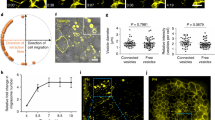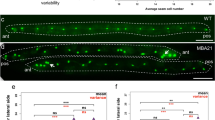Abstract
THE development of the cellular slime moulds demonstrates very simple pattern formation. Cells from an apparently homogeneous population come together to form an aggregate which differentiates into a pattern of only two types of cell, stalk and spore. These are rearranged spatially to form the fruiting body. A striking feature of this pattern is that the proportions of stalk and spore are relatively constant over a wide range of size of aggregate1. Although the aggregate can differentiate directly into a fruiting body2 it usually migrates as a coordinated irritable whole in the form of a tapered cylinder called the grex. It is known that any sufficiently large part of the migrating grex can give rise to a normal fruiting body, and, in this sense the development of the slime mould shows considerable regulation3,4. At present most workers accept that during migration the front third of the grex becomes prestalk cell and rear two-thirds prespore1. It is necessary for an understanding of pattern formation to know when this pattern is specified and when the cells become determined. In view of the capacity of the grex to regulate, it is of great interest that histochemical and ultrastructural differences between prespore and prestalk cells in the grex have been found by various workers1,5–9, because such differences are clearly reversible.
This is a preview of subscription content, access via your institution
Access options
Subscribe to this journal
Receive 51 print issues and online access
$199.00 per year
only $3.90 per issue
Buy this article
- Purchase on Springer Link
- Instant access to full article PDF
Prices may be subject to local taxes which are calculated during checkout
Similar content being viewed by others
References
Bonner, J. T., in The Cellular Slime Moulds (Princeton University Press, 1967).
Gerisch, G., Current Topics Develop. Biol., 3, 157 (1968).
Raper, K. B., J. Elisha Mitchell Sci., 56, 241 (1940).
Raper, K. B., Growth Supp. (Symp. 3), 5, 41 (1941).
Bonner, J. T., Amer. Naturalist, 86, 78 (1952).
Bonner, J. T., Quart. Rev. Biol., 32, 232 (1957).
Takeuchi, I., in Nucleic Acid Metabolism, Cell Differentiation and Cancer Growth (edit. by Cowdry and Seno) (Pergamon Press, 1969).
Takeuchi, I., and Sato, T., Jap. J. Exp. Morphol., 19, 67 (1963).
Hohl, H. R., and Hamamoto, Susan, J. Ultrastruct. Res., 26, 441 (1969).
Wolpert, L., J. Theoret. Biol., 25, 1 (1969).
Author information
Authors and Affiliations
Rights and permissions
About this article
Cite this article
FARNSWORTH, P., WOLPERT, L. Absence of Cell Sorting Out in the Grex of the Slime Mould Dictyostelium discoideum. Nature 231, 329–330 (1971). https://doi.org/10.1038/231329a0
Received:
Revised:
Issue Date:
DOI: https://doi.org/10.1038/231329a0
This article is cited by
-
A cell-marking technique for a cellular slime-mold
Experientia (1981)
-
Pattern formation in the absence of polarity in Dictyostelium discoideum
Nature (1977)
-
Cell sociology and the problem of position effect: Pattern formation, origin and role of gradients
Acta Biotheoretica (1977)
-
Role of the Surface Sheath in the Control of Morphogenesis in Dictyostelium discoideum
Nature New Biology (1972)
Comments
By submitting a comment you agree to abide by our Terms and Community Guidelines. If you find something abusive or that does not comply with our terms or guidelines please flag it as inappropriate.



